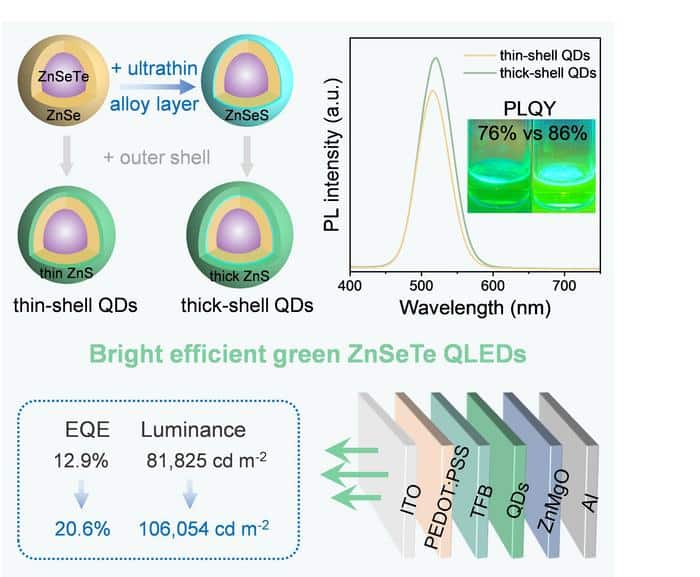QD-LEDs represent a highly promising next-generation display technology. However, with increasing global environmental awareness, the rapidly developing QD-LED technology is also facing new challenges: how to maintain high performance while ensuring low toxicity and environmental sustainability. This has driven InP and ZnSe quantum dots (QDs), two types of environmentally friendly QDs systems, to become research focal points.
Although InP QDs can flexibly tune their emission spectra by precisely controlling the crystal nucleus size, their preparation process relies on toxic and expensive phosphorus precursors, limiting their prospects for large-scale application. In contrast, ZnSe QDs, by alloying with narrow-bandgap ZnTe to form ternary ZnSeTe QDs, achieve spectral tuning. This not only demonstrates remarkable convenience in spectral control but also offers sustainability and cost-effectiveness advantages, thus opening up a green and cost-effective path for the future development of QD-LEDs technology. Nevertheless, ZnSeTe-based QDs face performance bottlenecks in green and red QD-LEDs due to the lack of effective defect passivation strategies.
Professor Huaibin Shen and his colleagues from Henan University have published their latest research findings in Science Bulletin, successfully developing bright and efficient green-emitting ZnSeTe-based QD-LEDs. The research team employed their developed “low-temperature injection and high-temperature growth” method and successfully synthesized bright green-emissive thick-shell ZnSeTe/ZnSe/ZnSeS/ZnS QDs by inserting an ultrathin ZnSeS alloy interlayer to assist the growth of a thickened ZnS outer shell. The introduction of the ZnSeS interlayer effectively alleviated the lattice mismatch between the ZnSe and ZnS, and the thickened shell further passivated the surface defects, thereby enhancing the radiative recombination efficiency and optical stability of ZnSeTe-based QDs. Furthermore, this shell-tuning strategy also resulted in a slightly upward shift in the energy level structure of the QDs, which facilitated the reduction of the hole injection barrier and the suppression of excess electron injection, ultimately promoting balanced carrier injection.
As a result, the peak external quantum efficiency (EQE) of the thick-shell green QD-LEDs demonstrated a substantial enhancement, rising from 12.9% to 20.6%, accompanied by a luminance exceeding 100,000 cd m−2, establishing a new record for the highest brightness among ZnSe- and ZnSeTe-based QD-LEDs. Meanwhile, the operational stability of the devices also improved significantly. This structural design offers novel insights into the growth control and defect passivation of ZnSeTe-based QDs, laying a crucial foundation for the development of high-performance environmentally friendly electroluminescent devices.
The full study titled “Bright and efficient green ZnSeTe-based quantum-dot light-emitting diodes with EQE exceeding 20%” was published in the journal Science Bulletin and can be found online here (DOI: 10.1016/j.scib.2025.02.042).
